At the end of the road, south of Puerto Viejo on Costa Rica’s Caribbean coast, you’ll find the Gandoca-Manzanillo National Mixed Wildlife Refuge. This protected land is the ideal place to spot amazing wildlife like sloths, monkeys, birds, lizards, and even snakes. It also has picturesque beaches and gorgeous coastlines. In this post, we’ll share our experience hiking the Gandoca-Manzanillo Wildlife Refuge with a guide.
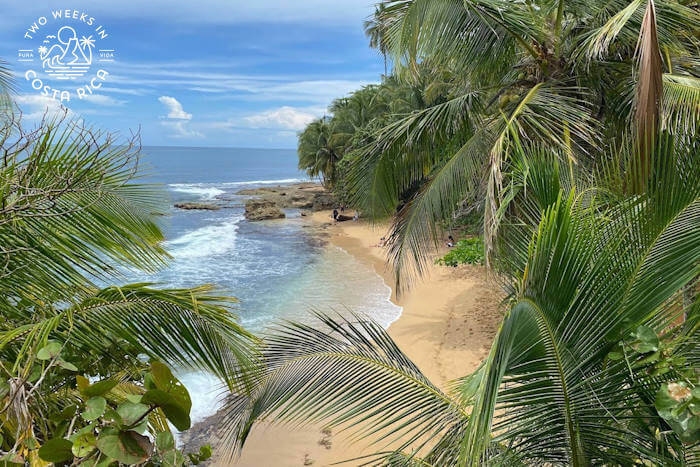
Location and Layout
The Gandoca-Manzanillo National Mixed Wildlife Refuge (Refugio Nacional Mixto de Vida Silvestre Gandoca-Manzanillo) is located on Costa Rica’s southern Caribbean coast near the popular destination of Puerto Viejo de Talamanca. From San Jose or SJO International Airport, the reserve is about 4.5-5 hours away.
The reserve has two ranger stations where you can start your visit.
The most popular is the Manzanillo Sector, found at the end of the paved road (Route 256). This is about 25 minutes south of Puerto Viejo. The other entrance is the Gandoca Sector. This is closer to the Panama border and harder to access.
In total, the Gandoca-Manzanillo refuge protects an impressive 25,910 acres (10,485 hectares). About half is wild jungle, while the other half is coastline and reefs.
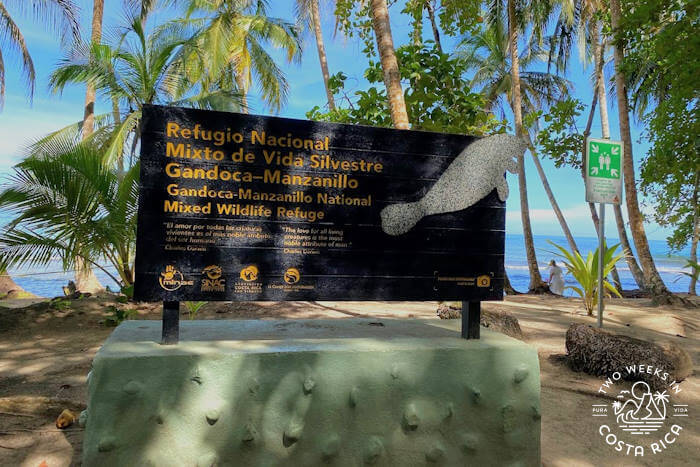
Remoteness and Safety
A deterrent for some thinking about visiting Gandoca-Manzanillo are reports of robberies along the trail.
People have had their cameras, backpacks, phones, wallets, and other belongings taken by thieves who approach them on the remote trails. This doesn’t happen all the time but enough to be worrisome. This was a concern for us too, which is why we hired a local guide.
Our guide knew everyone in the area, including all the reserve employees, parking attendants, coconut vendors, and other guides we passed. He also carried a small machete in a sheath on his belt, just for good measure.
We did not come across any sketchy people along the trails but still felt much better having a guide with us. He also added a lot to our experience, which we will explain below.
Tip: See the end of this post for more info on how we can help you hire a guide.
Hiking the Gandoca-Manzanillo Wildlife Refuge
Meeting Our Guide
After driving south from our hotel in Playa Cocles, we arrived in Manzanillo around 8:00 a.m. Through the rows of palms, we could see that the beach outside the entrance was already getting busy with locals. It was a Sunday and school vacation in Costa Rica.
We soon found our guide, Haniel.
Entering the Reserve
Haniel led us to the small ranger station where he paid our entrance. Gandoca-Manzanillo is still a small, uncrowded reserve and entrance is by donation only.
Quick Wildlife Sightings
As we crossed the short suspension bridge to enter the reserve, Haniel pointed out some things in the creek below.
Two Night Herons were perched in a tree and a Jesus Christ lizard skittered along the bank. These lizards are known to run so quickly that they can cross the surface of the water without falling in.
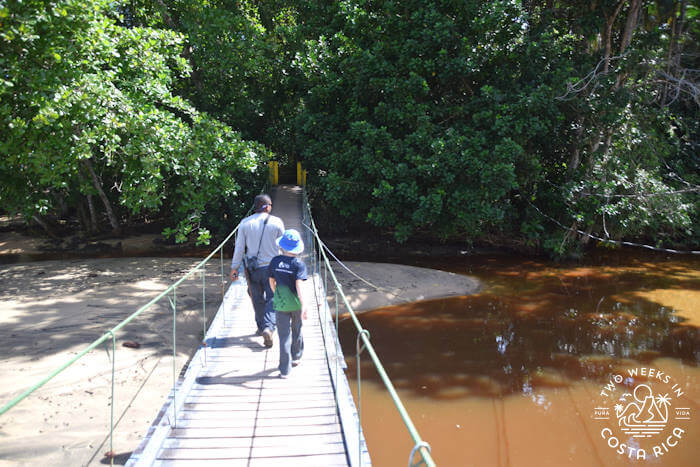
On the other side, Haniel asked what we were hoping to see today. Our kids quickly told him they wanted to see a jaguar (a far reach), but we also mentioned wanting to spot snakes and cool birds.
Haniel asked if we liked sloths. We, of course, said that we did. He then pointed out one that was directly above us in a tree.
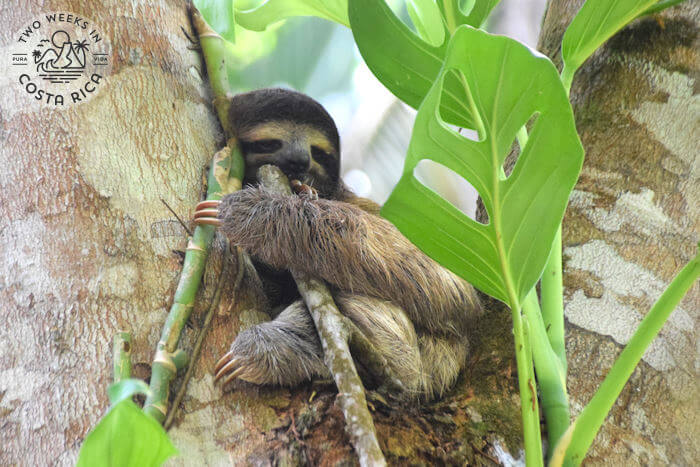
We continued a few hundred feet and Haniel showed us a helmeted iguana basking on a small tree. We had only seen this type of iguana once before in Costa Rica so were excited to get some pictures. They have a funny shaped head and sort of resemble chameleons.
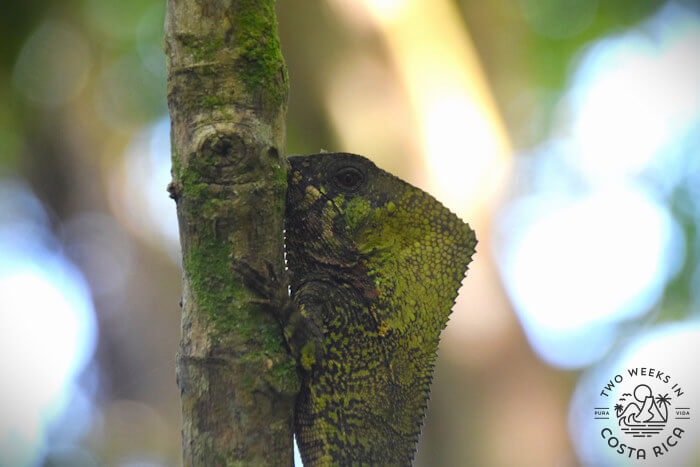
Off the Tourist Trail
While most visitors followed the wide main trail along the coast, Haniel directed us inland on a trail he liked called the Hidden Bridge Trail (Sendero Puente Escondido). There were no other people around.
After a short walk through the rainforest, we came to a rustic covered walkway.
Here, we saw another helmeted iguana and a coati (a raccoon-like animal with a long snout) up in a tree.
Later, back on the dirt trail, Haniel took out his flashlight. Kneeling next to a rotting log, he asked our kids to look inside. There, hiding in the shadows, was a large tarantula!
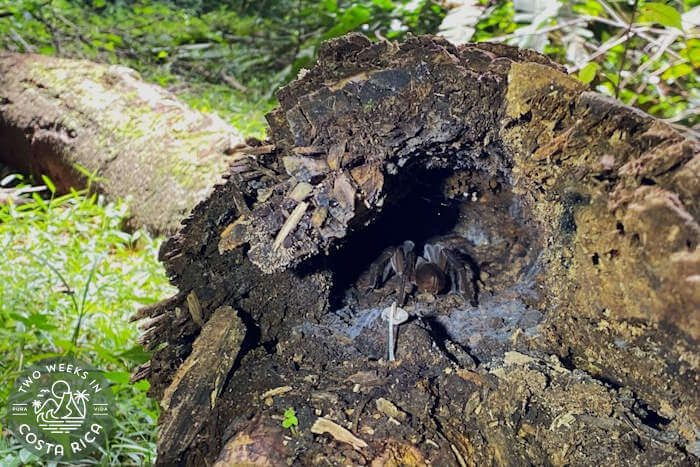
When this trail came to an end, Haniel led us through the woods on a very faint path. Without him, we wouldn’t have even noticed it. This was where our tour really went off the tourist trail.
Magnificent Trees
As our family followed Haniel over the crest of a small hill, we realized we were in thick primary forest. Tall trees surrounded us and the forest floor was covered with undisturbed leaves. Haniel began telling us all about the different trees we passed.
We saw balsas, known for their lightweight wood that is often used to make boats. We gazed at towering guacima colorado trees that were well over 100 years old. There were even rubber trees.
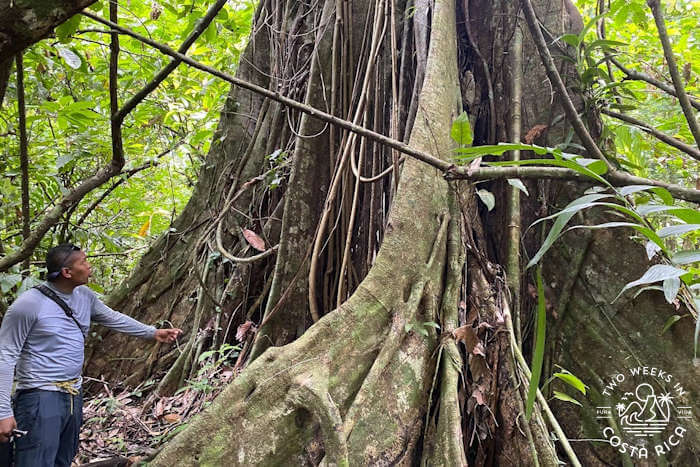
Haniel took a few moments at each one to tell us some quick information. We learned about the giant mountain almonds that nearly went extinct for their desirable wood. They are also the favorite tree of the endangered Great Green Macaw, which we had seen at Ara Manzanillo nearby.
At the base of one tree, Haniel found a long stick and began tapping the roots. Soon some bullet ants came rushing out, investigating what was going on. These ants have a powerful sting that people say hurts as much as getting shot.
Poison Dart Frogs
Around every corner, there seemed to be another surprise. Haniel told us he thought he could find some snakes and was leading us to a spot he knew.
Along the way, we came across a couple of interesting frogs. One was a tiny strawberry poison dart frog. These bright red frogs are like the blue-jean poison dart frog but lack the blue color on their legs. With small black speckles on their red skin, they do resemble strawberries.
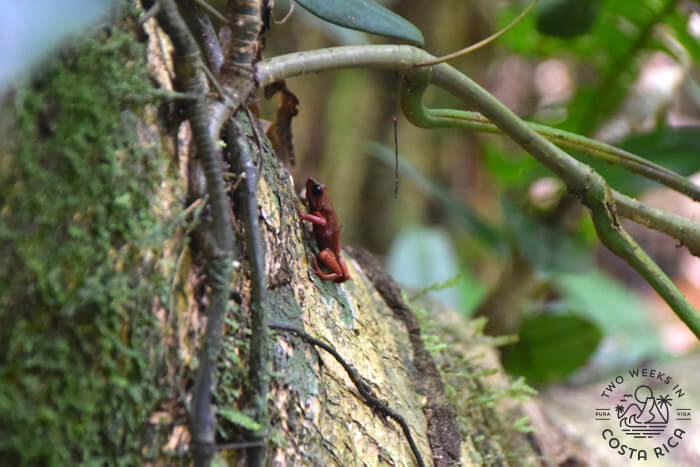
Another exciting encounter was a Talamanca rocket frog. We had never seen this before. They are endemic to the area and similar to poison dart frogs, but without any poison.
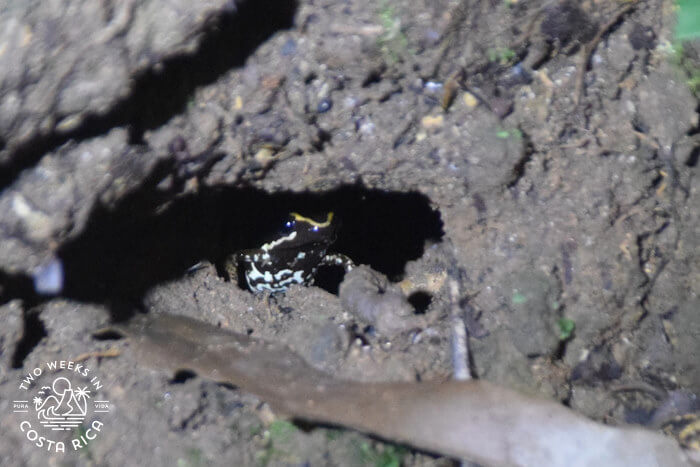
Snakes
It wasn’t much longer before Haniel found our first snake of the day. It was an eyelash pit viper. This one was brownish and blended in with the tree trunk.
These snakes can be all sorts of different colors. Later, we saw a bright yellow one. Haniel approached it and carefully took some close-ups with our phone. He told us that these snakes are not aggressive but highly venomous.
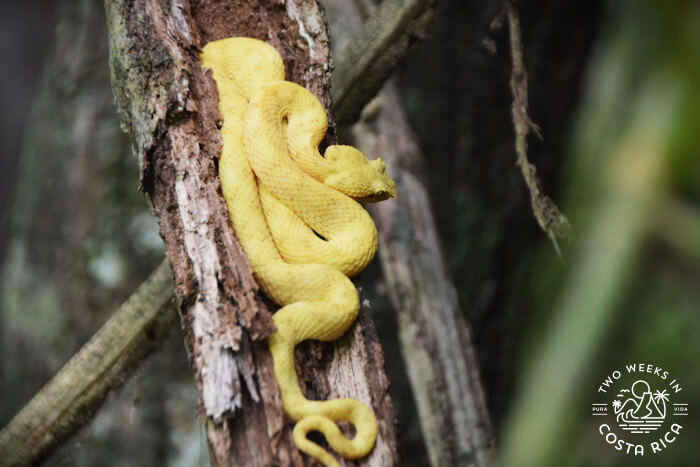
Beautiful Birds
As we weaved through thick forest and underbrush, Haniel continued to show us special plants, seeds, insects, spiders, and many birds.
Some of the birds we spotted were the Common black hawk, Yellow-throated Toucan, Crested Guan, and Collared Aracari.
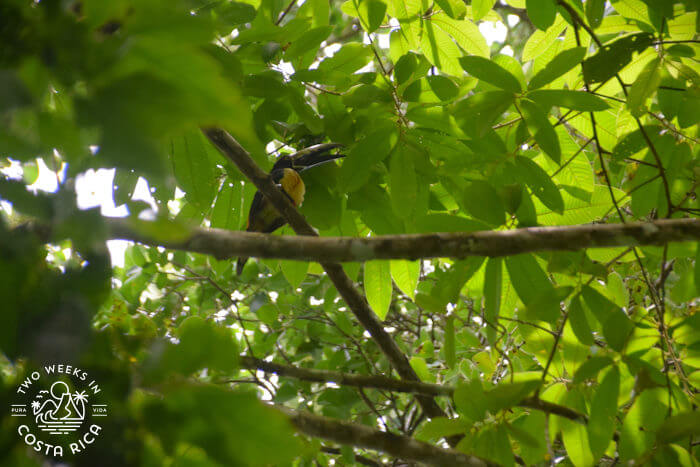
Finishing with a Coastal View
Folding away some leaves, not even on a path at this point, we suddenly stepped back onto the main trail. A few people walking past seemed surprised to see us.
We followed the trail north, back toward the ranger station, until we reached Miss May Point.
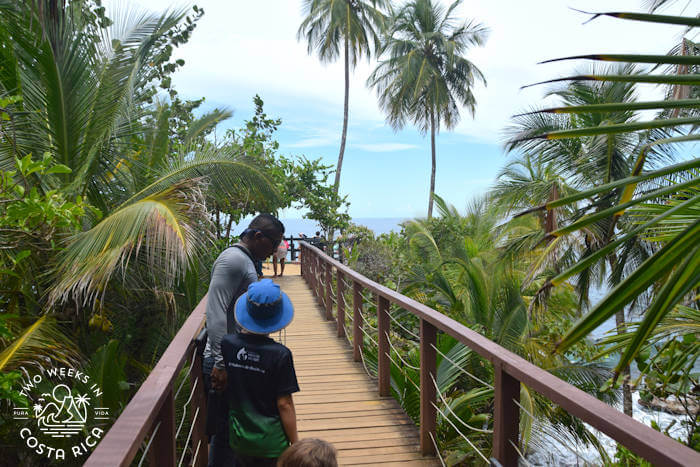
Miss May Point is probably the most iconic spot in the reserve. Many people come here to take pictures of the small island just offshore and jungle-backed beach.
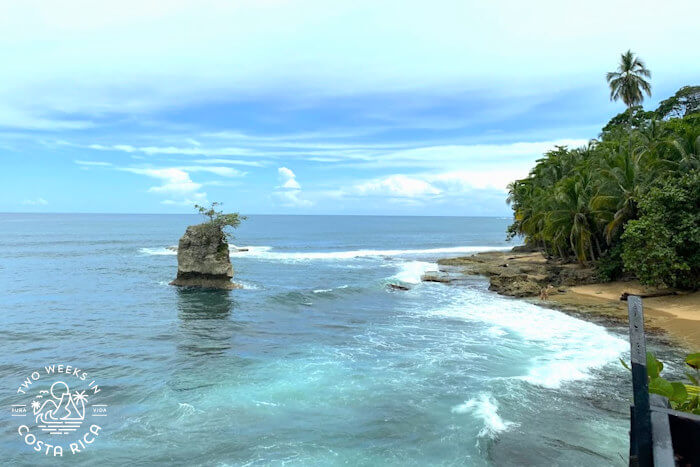
This was a touristy part of our visit but something we wouldn’t have wanted to miss. The views were gorgeous.
Just 15 minutes later, we were back at our car sipping some coconuts with our faithful guide. It was the perfect ending to our wildlife-filled hike through the Gandoca-Manzanillo Wildlife Refuge!
How to Visit the Gandoca-Manzanillo Refuge
Hours
Open every day from 6:30 a.m. to 3:00 p.m. (last entrance)
Cost
Voluntary donation to enter (cash or credit card). Proceeds go toward trail maintenance and park administration costs.
Self-Guided Hike
From the ranger station, the main trail is 5 km (3.4 miles) to Punta Mona. According to the ranger, this takes about 2.5 hours there and back. Miss May Point (Mirador Manzanillo) is only about 15 minutes from the ranger station along a well-trodden path.
Hiring a Guide
While we usually hike on our own, we were happy that we hired a guide for our visit to Gandoca-Manzanillo. We never would have seen as much wildlife without him and he made us feel safe on the trails.
If you are interested in using the same guide we did, please use the form below and our travel agency will take care of all the arrangements.
Guided tours cost $50 adults + tax, $25 children ages 6-11 + tax and go from 8:00 a.m. to 11:00 a.m./12:00 p.m. Entrance and fruit are included. *Transportation available for an additional charge.
Have a question about visiting the Gandoca-Manzanillo Refuge or want to share your experience? Leave a comment below.
Need more information to help you plan? Check out these articles:
Puerto Viejo de Talamanca: Caribbean Cool in Costa Rica – Learn about where to stay, what restaurants to eat at, and fun activities to do in the Puerto Viejo area.
Ara Manzanillo: A Great Green Macaw Tour – This quick tour will let you see dozens of beautiful Great Green Macaw parrots flying all around you in the wild.
Cahuita National Park: Wildlife Just a Step Away – Another less remote park in the area with outstanding wildlife and beautiful beaches.

